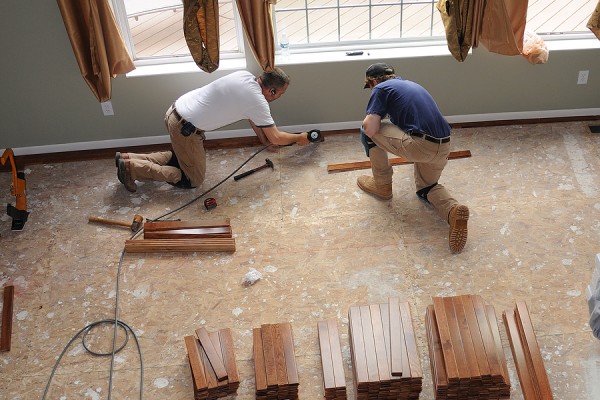Knowing major issues from cosmetic issues on a flip.
Buying distressed real estate can be a source of good money. However, in order to be able to successfully flip a property for profit, you need to be able to tell the difference between major issues that will be expensive to resolve and cosmetic issues that are relatively inexpensive to resolve, and, thus, yield a high rate of return.
Generally speaking, a good property will be an ugly duckling that you can quickly rehab for a relatively small investment of time, money and effort to reap big rewards. Properties with relatively minor issues, such as cosmetic defects, are typically a quick fix. They can yield a high profit margin. Properties with major problems, such as structural defects, are typically a lot less profitable. In a worst case scenario, they may wind up turning into a financial loss.
The Mysterious Sound of Running Water
If you do a walk through of an investment property, and you can hear running water when all the taps are turned off, you need to determine the source of the sound. This may be indicative of something small and easy to fix. Alternately, it may be indicative of a big, hidden expense.
There are some small problems that can cause the sound of running water, such as a leaky toilet tank that is slowly draining at all times and old washers that need to be replaced. In most cases, these types of leaks will cause a water bill to be a little higher than it needs to be, but they do not typically cause serious structural damage to the house.
You can check to see if it is a leaky toilet tank by one of two methods: Either cut the water off at the house main, wait a bit and see if one or more of the toilet tanks is running low on water, or cut the water off, flush all the toilets and see if the sound of running water stops shortly thereafter. This can typically be fixed by replacing the flush mechanism in the tank with new hardware or otherwise improving the seal between the tank and the toilet.
Old washers that need to be replaced typically result in a faucet constantly dripping. You can look for a dripping faucet, for mold or mildew growing on a damp surface in a sink or bathtub and wear on the surface of the sink or tub where the water constantly hits it. Washers are cheap to buy and not very hard to replace.
If the dripping has gone on for a very long time, you may want to repair or replace the sink or tub. Some kinds of materials are more vulnerable to this issue than others. In many cases, this will be a largely cosmetic defect. It does not necessarily impact the functionality of the sink or tub. So it may not need to be replaced, even if it is visibly marred.
If you have ruled out small problems, but are still hearing water running, you may have a more serious problem, such as a slab leak. This is where a pipe running under the slab foundation has sprung a leak.
Even in cases where the house is occupied by the owner, a slab leak can rapidly turn into thousands of dollars worth of property damage before it gets tracked down. When you are dealing with a foreclosure property, it is not uncommon for it to have been sitting empty for some time prior to being purchased. During a long vacant period, a leak can go completely unnoticed and quietly cause many thousands of dollars worth of damage before it gets signed over to an investor and properly inspected for the first time.
A slab leak that has gone on for some time can damage the subfloor and flooring, such as carpeting or hardwood floors. It can damage the foundation itself. It can even get the ground so soggy that the underpinnings of the foundation are not firm. If it has gone that far, it can potentially cost tens of thousands of dollars to get everything fixed and back up to code.
Although they are very serious, slab leaks are not the only type of leak out there. If there is a leak somewhere in the system, the pipes may be rotting away. Simply fixing that one leak will increase water pressure throughout the system. If all the pipes are in poor shape, the increase in water pressure may lead to the system springing new leaks elsewhere.
Thus, even if the leak has miraculously not caused serious damage to any other part of the structure, leaking pipes can mean that the plumbing system for the entire house needs to be upgraded. Unsurprisingly, this is no small matter. So, always thoroughly investigate any mysterious sounds of running water that you hear when inspecting an investment property.
Structural Problems versus Minor Dings
You should walk around the property and look at walls, floors, doors, windows, etc. The odds are good that you will see a lot of little defects. Some may seem small but may really be a huge headache. Others may seem like a big deal, but turn out to be a minor annoyance. With practice, it is possible to get decent at separating the wheat from the chaff of rehab problems yourself, without first paying for professional assistance.
First impressions can make a big negative impression on some people. For example, trying to turn the knob on the front door of a property that you are entering for the first time and having the knob essentially come off in your hand can really make some people think the property is a terrible disaster. The truth is that a loose door knob is a minor fix and not something to worry about per se.
Door hardware is cheap and easy to acquire and can be readily installed by most people without hiring a professional contractor. Yes, it is part of the structure. No, it is not a very serious problem.
What you want to do is look for evidence of serious structural problems. Something like a sticky door can be evidence of a minor problem or a major problem. You want to get decent at distinguishing the two. You want to learn what makes one sticky door no big deal and another sticky door a sign of a potentially expensive problem.
One of the most serious types of structural problem is a problem with the foundation of the house. Such problems are generally on the expensive side. Because the foundation is under everything, it is also mostly hidden from view. Thus, they also are often hard to spot. In most cases, foundation problems are inferred from other evidence rather than spotted directly.
Here is one simple test that anyone can apply for cheap: Put a marble on the floor. Does it roll away? If it rolls to one side of the house, it could mean that the house needs peering because the foundation is sinking on one side, kind of like the Leaning Tower of Pisa.
You should also look for these other details as potential evidence of foundation problems:
- Cracks in the drywall
- Windows or doors that stick when you try to open them
- Basement floors that are sunken
- Cracks in the mortar between bricks that forms a stair-like pattern
- Gapping between walls and window or door frames
- Leaks in the basement
- Cracks in the floors or in foundation walls
Of course, most of these can be there for reasons other than foundation problems. So, let’s talk about some of the things to look at to try to tell whether these are minor dings that can be resolved inexpensively or evidence of larger problems.
If a door sticks, you need to determine why. Is it sticking because of rubbing against the frame? This is potentially a big problem. But if it is sticking because the hinges are rusted, this is not a big problem. Hinges can be oiled or replaced inexpensively. You are looking for doors that stick because the frame is leaning, not because the hardware is in poor shape.
Cracks in the mortar or missing chinking may just be a sign of weathering. But when the cracks form a stair-step pattern, this is generally going to indicate foundation problems. It indicates serious stress being put on a brick wall in a manner that cannot be readily replicated via other problems.
If the paint is peeling, the yard is overgrown and the house is downright ugly, this is not a big problem per se. In fact, when looking to flip a house, this is exactly the kind of property where a little elbow grease can pay big dividends.
Do not be intimidated by an eyesore of a property. As long as its ugliness is only skin deep, a little paint, polish and clean up can go a long way towards improving the sale price for very little upfront investment on your end. In most cases, properties that are ugly but structurally sound are going to be the most profitable. These are what they call “good problems to have.”
Basements can be damp for reasons other than leaks. Dampness is never good, but some causes of dampness in a basement are more serious than others. If it is not due to structural problems with the foundation, it may be due to contact with damp soil. This can sometimes be resolved with a waterproofing sealer applied topically like paint. You may also need other products to help protect against mildew.
The Trials and Tribulations of Older Homes
Older homes are often in very desirable, pedestrian-friendly neighborhoods. Many of them have features that can no longer be recreated because zoning laws and housing codes have changed. Their unique, highly desirable features are grandfathered in. The house can stay, but another one like it cannot be built. These facts can help push the price of some older homes up to what can sound like an astronomical price for a house of its size.
Thus, they are potentially a big win for an investor who manages to pick one up at auction. But they also come with a lot of potential pitfalls. At times, some of these pitfalls can be extremely expensive.
Depending upon the age of a home, it can have many serious problems that would not exist in a house that was built more recently. For example, lead paint was banned in 1978. Homes that were built before that year may need to be remediated for lead paint, a toxic substance that can cause serious neurological problems. At a minimum, they need to be checked for lead paint.
For houses from an even earlier era, radiators were a common means of heating the structure. Old radiators are often coated in multiple layers of lead paint. More seriously, some of them used a mercury seal to allow the water to run hotter without hitting the boiling point.
When removed, radiators with a mercury seal can leave a substantial mercury spill. A mercury seal for a radiated heat system used far more mercury than your typical household thermostat would hold. The amount involved can be several tablespoons. If this does not sound like a lot, keep in mind that four tablespoons adds up to a quarter of a cup. That much mercury would constitute a very serious and hazardous spill.
A large mercury spill is an extremely serious problem that can cost tens of thousands of dollars to properly remediate. Mercury is a neurotoxin, and it is classified as a hazardous material. Thus, if you think you see evidence of a mercury spill, this is the sort of thing where you call the fire department. If the spill is large enough, at some point, people will need to show up in hazmat suits to take care of it. It is not a candidate for a cheap do-it-yourself solution.
Keep in mind that the radiators do not necessarily need to still be in the house for this to be an issue. If the mercury was spilled during a previous renovation or when the radiators were removed, it may have simply gone unnoticed. Or it may have occurred during an era when people were generally less aware of how serious something like this is, so they did nothing about it.
Thus, there could be a substantial spill hidden inside a wall or ceiling. It may be revealed when something gets renovated, repaired or upgraded. Or you may find it when you do a walk through of a vandalized property where the structure has been damaged, revealing the spill. So do not assume that an old house that does not currently have radiators cannot have this problem. It is less likely, but not entirely out of the question.
Older homes can also have lead pipes, rotting pipes and other serious plumbing problems. Lead pipes are no longer allowed. If there are serious defects, it may be necessary to replace most or all of the plumbing system. Needless to say, this is not cheap.
Additionally, older homes can have an out of date electrical system. Homes built before television sets, microwave ovens and computers were the norm tend to have fewer outlets and tend to have less electrical capacity. When you plug everything in and turn it all on, you wind up blowing fuses.
For context, if you have ever lived in an older home, everything may be fine while you have the lights, computer and TV on, but the minute you try to microwave something, the fuses blow and you are plunged into darkness. This is not merely an annoyance. It is a potential fire hazard. Upgrading the entire electrical system to add capacity and bring it up to code is not a do-it-yourself job and can cost thousands of dollars.
Older homes are also excellent candidates for foundation problems, termite infestations and other serious problems. They were built in an era when a lot of our modern building codes and general expectations for current housing standards simply did not exist. They have also had a lot of time for problems to either develop or fester. You should always inspect an older home thoroughly.
Visible Dirt and Debris
Auction property is almost always property that is a bit messy. You can assume that no one has gone through recently to tidy up. It is also not uncommon for properties to have been vandalized while they were vacant and waiting to be auctioned.
However, even if the place has not been vandalized, it frequently looks rather dirty and unkempt. Some kinds of dirt and debris are just surface dirt and are readily cleaned up. But, others are an indicator of a deeper problem.
A small pile of brown stuff that looks like a pile of coffee grounds on the kitchen counter might be exactly what you think: Coffee grounds. On the other hand, it may also turn out to be termite droppings from the cabinet above. This can cost a fortune to resolve.
Termites are always an expensive problem, so you should learn to look for evidence of termites in any wooden structures, including kitchen and bathroom cabinets, wood siding and wood framing. Look for wood that looks rough or odd in some way. Look for insects that look like flying ants. Ants can have wings. So can termites. Most people cannot readily tell them apart.
More often than ants, termites drop their wings when they land. Like many insects, they are attracted to light. Thus, insect wings cluttering a window sill are another potential sign of termites. Termites can also cause floors, walls or ceilings to sag. Their activity can also cause what looks like water damage.
You need to take a close look and determine if dark smudges are just dirt or if it is black mold or evidence of smoke damage from a structure fire. Fire damage and mold are expensive problems that can run into serious money. In contrast, dirt is something that can be readily cleaned up for very little time, money and effort.
Replacing broken windows is not cheap, but, as long as there aren’t too many broken window, it is not likely to be a huge expense either. If it is trashed out and ugly, this is only a serious problem if the trash is something that is rotting, molding and attracting vermin. Otherwise, these are good problems to have. Cleaning up the mess, doing some minor repairs and freshening up the place can translate to a big profit margin.
If the yard looks terribly overgrown, you may need to do little more than mow the lawn and put out some weed killer. But you should also check to see if it indicates a backed up septic system that needs to be serviced
However, if there are larger plants, such as an abundance of overgrown trees, you also need to check for roots in the sewer or plumbing lines and potentially roots invading the foundation of the house. If the property has been empty or neglected for a long time, trees can also grow through an existing chain link fence, becoming enmeshed in the fence. When that happens, removing the tree typically involves cutting it at two points, one on each side of the fence, and leaving part of it stuck in the fence. The only way to fully resolve it is to replace that portion of the fence as well.
Although it is handy to be knowledgeable about such things, keep in mind that if you do see what you think is evidence of major problems, yet you remain unsure, you should hire a professional inspector to get a definitive answer. You do not have to have all the answers yourself. You just need to know how to get the answers.





